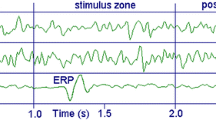Abstract
Autointervalograms of the extremums of human electroencephalograms (EEGs) recorded under periodic stimulation were analyzed. The method was compared with visual EEG analysis and EEG sinusoid testing. It was shown that, in most cases, the construction of intervalograms is as good as, or even better than, the other two methods, because it allows us to detect the responses and obtain additional information.
Similar content being viewed by others
References
Solomatin, V.F. and Shuvaev, V.T., Cross-Intervalograms for Analyzing the Electrical Activity of the Brain, Zh. Vyssh. Nervn. Deyat., 2005, vol. 55, no. 5, p. 707.
Svyatogor, I.A., Classification of the EEG Patterns and Their Neurophysiological Interpretation in Maladaptation Disorders, Biol. Obr. Svyaz’, 2000, vol. 2, no. 3, p. 10.
Author information
Authors and Affiliations
Additional information
Original Russian Text © V.F. Solomatin, I.A. Svyatogor, V.T. Shuvaev, 2010, published in Fiziologiya Cheloveka, 2010, Vol. 36, No. 2, pp. 44–49.
Rights and permissions
About this article
Cite this article
Solomatin, V.F., Svyatogor, I.A. & Shuvaev, V.T. On the use of EEG autointervalograms for analyzing the responses to periodic light stimulation. Hum Physiol 36, 158–163 (2010). https://doi.org/10.1134/S0362119710020052
Received:
Published:
Issue Date:
DOI: https://doi.org/10.1134/S0362119710020052




